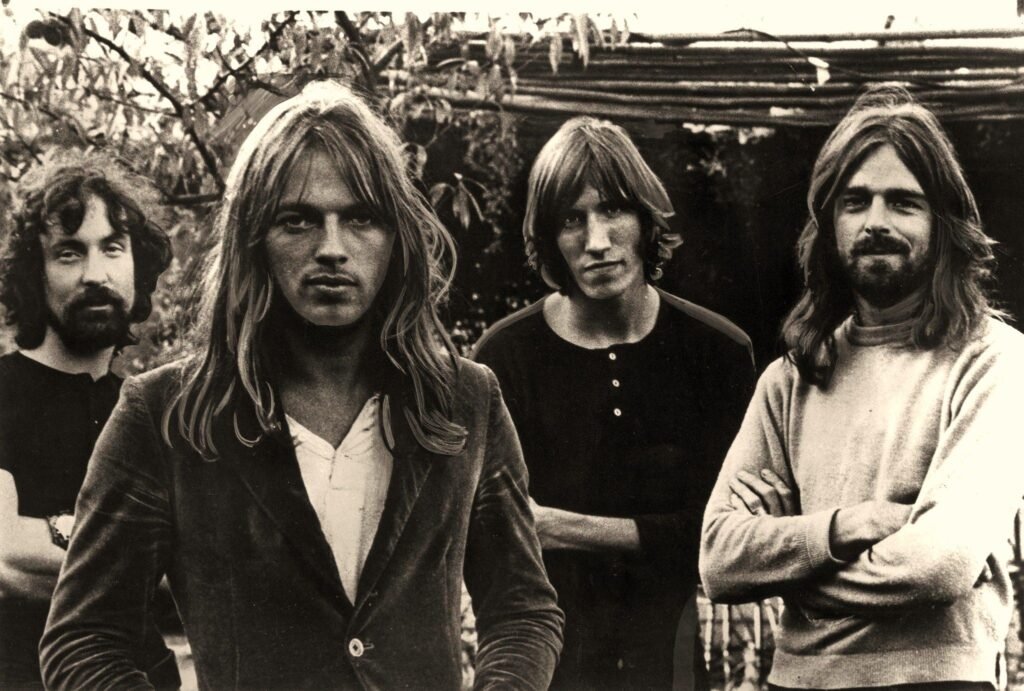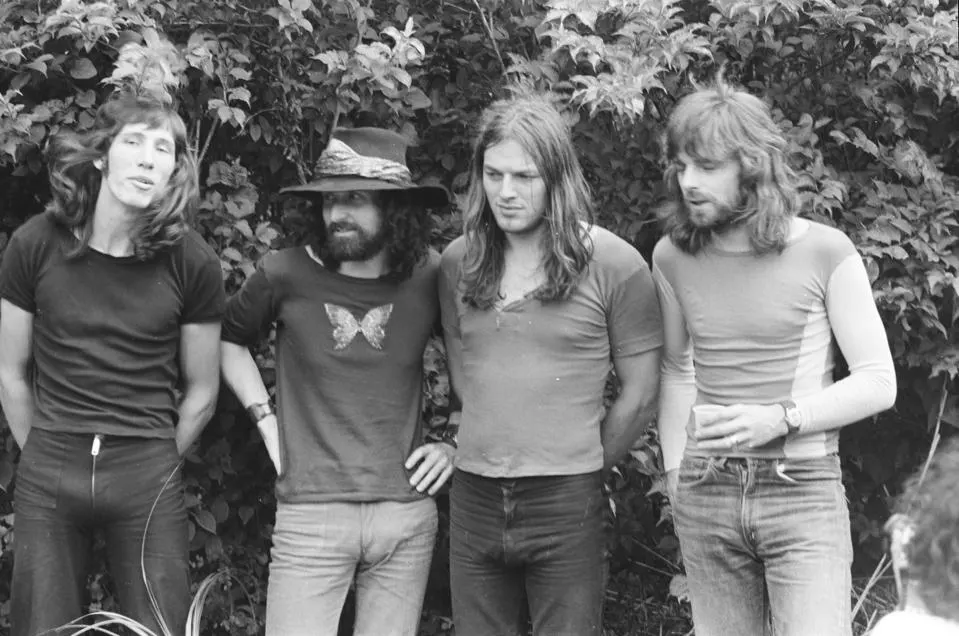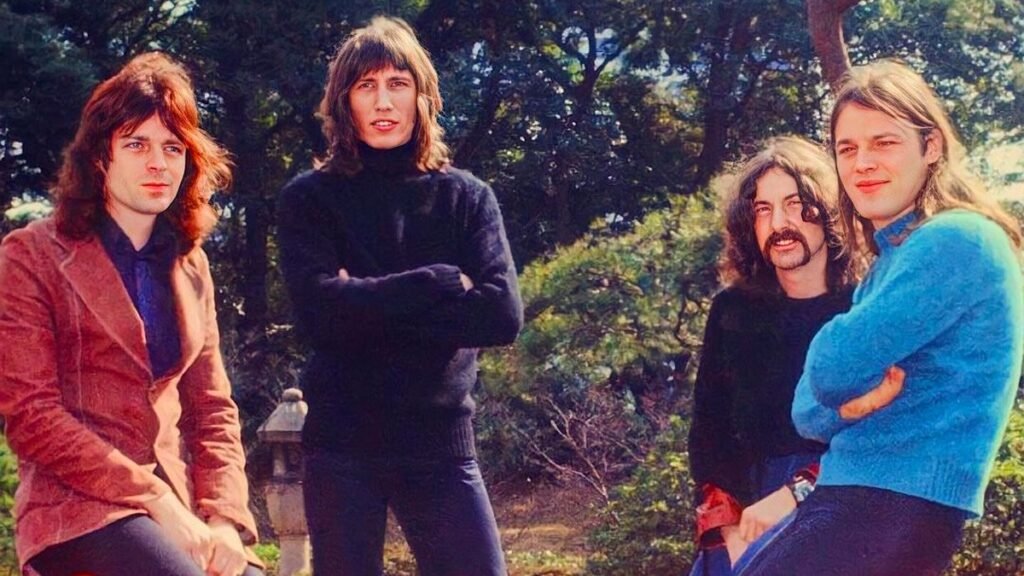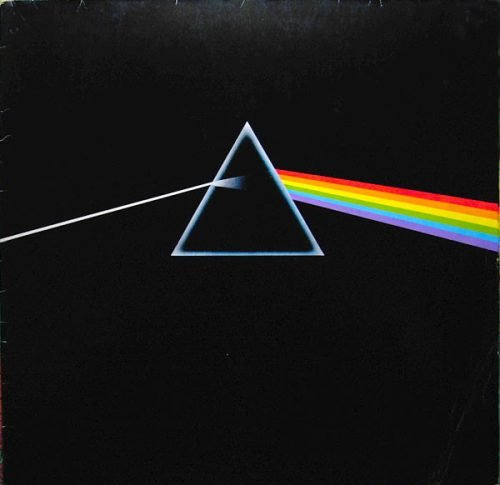Released in 1973, Pink Floyd’s The Dark Side of the Moon stands as a monumental achievement in their discography and in the broader landscape of rock music. Situated as the eighth studio album by the British progressive rock band, this record marked a significant evolution from their earlier work. Pink Floyd had already established themselves as pioneers in the psychedelic and progressive rock scenes with albums like The Piper at the Gates of Dawn (1967) and Meddle (1971), but The Dark Side of the Moon elevated their sound to unprecedented levels of sophistication and cohesion.
In the early ’70s, the music landscape was rife with experimentation and the blending of genres. Bands were pushing the boundaries of rock, incorporating elements of jazz, classical music, and avant-garde soundscapes. Within this milieu, Pink Floyd emerged not just as participants, but as innovators, driving forward the possibilities of concept albums and sonic storytelling.
Artistic Intentions
With The Dark Side of the Moon, Pink Floyd aimed to create an album that was not only musically groundbreaking but also thematically profound. The band sought to explore complex human experiences and societal issues, weaving them into a cohesive auditory journey. Roger Waters, the band’s primary lyricist, has often spoken about the album’s focus on themes such as mental illness, the pressures of modern life, and the passage of time. These concepts are universally resonant, giving the album a timeless quality.
From the iconic prism cover art designed by Storm Thorgerson, symbolizing the album’s exploration of light and sound, to the meticulously crafted tracks that seamlessly flow into one another, The Dark Side of the Moon was intended to be an immersive experience. The band utilized innovative studio techniques, including multitrack recording and tape loops, and incorporated non-traditional sounds, such as heartbeats and spoken word, to create a rich, textured soundscape.
In interviews, members of Pink Floyd have emphasized their desire to make an album that was both sonically adventurous and emotionally impactful. They succeeded in crafting a work that not only reflects the anxieties and alienation of the modern world but also offers moments of beauty and transcendence. As a result, The Dark Side of the Moon stands as a profound statement of artistic intent, capturing the essence of human experience through the medium of music.
Sonic Exploration

The Dark Side of the Moon is renowned for its exceptional production quality, which was groundbreaking for its time. Engineered by Alan Parsons, the album boasts a clarity and precision that set a new standard in the music industry. The production is crisp and meticulous, with each instrument and vocal track finely balanced to create a lush, immersive soundscape. The use of multitrack recording allowed the band to layer sounds intricately, contributing to the album’s depth and complexity.
This high-fidelity production plays a crucial role in conveying the album’s themes and mood. The clarity of sound enables listeners to discern the subtle nuances and textures within each track, enhancing the emotional and psychological impact of the music. For instance, the haunting clarity of Clare Torry’s wordless vocals on “The Great Gig in the Sky” evokes a sense of existential awe and melancholy, aligning perfectly with the album’s contemplation of life and death.
Musical Arrangements
The musical arrangements on The Dark Side of the Moon are masterfully crafted, showcasing Pink Floyd’s innovative approach to composition and performance. The album opens with the ethereal “Speak to Me/Breathe,” which transitions seamlessly from an ambient sound collage to a lush, melodic track. This fluidity in transitions is a hallmark of the album, with each song blending into the next to create a continuous, cohesive listening experience.
Instrumentally, the album is rich and diverse. David Gilmour’s guitar work is both evocative and technically proficient, ranging from the soulful blues licks on “Money” to the searing solos on “Time.” Rick Wright’s keyboards provide a textural foundation, from the dreamy synthesizer washes on “Any Colour You Like” to the poignant piano on “Us and Them.” Roger Waters’ bass lines are both rhythmic and melodic, underpinning the harmonic structure while adding a sense of urgency and drive.
The vocal arrangements are equally compelling. The band employs a mix of lead and backing vocals, often layering them to create a dense, atmospheric sound. Gilmour and Waters share lead vocal duties, their contrasting voices adding emotional depth and complexity to the lyrics. The use of spoken word samples and sound effects, such as the ticking clocks and cash registers, further enhances the narrative and thematic elements of the album.
Genre Elements
The Dark Side of the Moon defies easy categorization, blending elements from various musical genres to create a unique and innovative sound. At its core, the album is rooted in progressive rock, characterized by its ambitious compositions, experimental structures, and concept-driven approach. However, it also incorporates elements of psychedelic rock, with its use of extended instrumental passages, unconventional sounds, and mind-bending effects.
Additionally, the album touches upon blues, jazz, and electronic music. Tracks like “Money” feature a distinctive blues-rock groove, while “Us and Them” employs jazz-influenced chord progressions and saxophone solos. The use of synthesizers and tape loops throughout the album nods to the emerging electronic music scene, showcasing the band’s willingness to experiment with new technologies and sounds.
Lyrical Analysis

The Dark Side of the Moon delves into a range of profound and universally resonant themes. Central to the album are explorations of mental illness, the passage of time, greed, and the pressures of modern life. These themes are intricately woven throughout the lyrics, creating a cohesive narrative that captures the existential angst and disillusionment of the human condition.
One of the recurring motifs is the concept of time and its relentless, inevitable march. In “Time,” Roger Waters poignantly captures the anxiety of wasted years and the swift passage of life with lines like, “You are young and life is long and there is time to kill today / And then one day you find ten years have got behind you.” This theme is mirrored in the album’s sonic elements, such as the ticking clocks and urgent rhythms.
Another prominent theme is the struggle with mental health, encapsulated in songs like “Brain Damage” and “Eclipse.” Waters addresses the fragility of the human mind and the fine line between sanity and madness, drawing inspiration from former bandmate Syd Barrett’s mental health struggles. The lyrics, “The lunatic is on the grass… / And if the dam breaks open many years too soon,” evoke the precarious nature of mental stability and the societal stigmas surrounding it.
Lyrical Depth
The lyrics of The Dark Side of the Moon are characterized by their poetic depth and multifaceted nature. Waters’ writing is both introspective and observational, often employing metaphor and symbolism to convey complex ideas. For instance, in “Us and Them,” the dichotomy of conflict and unity is explored through imagery of war and peace, with lines like, “Us and them / And after all, we’re only ordinary men.” The use of contrast and repetition underscores the inherent contradictions in human nature and societal structures.
While some lyrics are relatively straightforward, conveying clear narratives or observations, others are more abstract and open to interpretation. This duality allows listeners to find personal meaning in the songs, making the album a deeply personal experience for many. “Brain Damage,” for example, uses vivid, almost surreal imagery to discuss madness, leaving room for varied interpretations and emotional connections.
Emotional Impact
The emotional resonance of The Dark Side of the Moon is profound, largely due to its evocative and introspective lyrics. The album elicits a wide range of emotions, from the melancholy reflections on mortality in “Time” to the existential dread of “Brain Damage.” The lyrics, combined with the music, create a powerful sense of empathy and contemplation.
Songs like “The Great Gig in the Sky,” despite its wordless vocals, convey intense emotion through Clare Torry’s expressive performance, which complements the lyrical themes of mortality and the afterlife. Meanwhile, “Money” critiques the corrupting influence of wealth with a biting, cynical tone, yet it also contains an undercurrent of dark humor.
Cohesion and Flow

One of the defining features of The Dark Side of the Moon is its seamless track progression, which contributes to the album’s reputation as a cohesive and immersive experience. The songs flow effortlessly into one another, creating a continuous auditory journey that feels more like a symphony than a collection of individual tracks. This meticulous arrangement ensures that each song not only stands on its own but also enhances the overall narrative and emotional arc of the album.
The journey begins with “Speak to Me,” a sound collage that sets the tone for the themes to come, leading smoothly into “Breathe,” which introduces listeners to the album’s contemplative atmosphere. The transitions between tracks are often marked by clever use of sound effects, such as the heartbeat that opens and closes the album, or the clocks that segue into “Time.” These elements create a sense of continuity and anticipation, drawing listeners deeper into the album’s thematic explorations.
Thematic Consistency
The Dark Side of the Moon excels in maintaining thematic consistency throughout its runtime. The album’s exploration of existential themes such as time, mental health, greed, and mortality is woven into every track, ensuring a unified narrative. Each song contributes to the overarching concept, reinforcing the album’s reflections on the human condition.
Musically, the album maintains a consistent style that blends progressive rock with elements of psychedelia, blues, and jazz. This hybrid sound is anchored by the band’s signature use of atmospheric keyboards, emotive guitar solos, and innovative studio effects. The cohesion is further strengthened by recurring musical motifs and lyrical themes, such as the repeated references to time and the cyclical nature of life, which appear in multiple tracks.
Despite this consistency, the album also incorporates dynamic shifts that prevent it from becoming monotonous. For example, the upbeat, funky groove of “Money” provides a contrast to the somber introspection of “Time” and the ethereal beauty of “The Great Gig in the Sky.” These shifts are skillfully managed to enhance the emotional impact without disrupting the overall flow.
Standout Tracks and Moments

Highlight Key Tracks
The Dark Side of the Moon is an album where every track contributes significantly to its overarching narrative and sonic tapestry, yet certain tracks stand out for their artistic merit, innovation, and emotional impact.
- “Time” – This track is a masterpiece of progressive rock, distinguished by its intricate arrangement and profound lyrics. The ticking clocks and alarm bells that introduce the song immediately capture the listener’s attention, setting the stage for a meditation on the passage of time. David Gilmour’s guitar solo in “Time” is particularly noteworthy, blending technical prowess with deep emotional expression, making it one of the most memorable moments on the album.
- “The Great Gig in the Sky” – Clare Torry’s vocal performance is nothing short of extraordinary. Her improvised, wordless singing conveys a spectrum of emotions, from sorrow to ecstasy, perfectly encapsulating the themes of life and death. This track stands out for its sheer emotional power and its innovative use of vocals as a primary instrument.
- “Money” – Known for its distinctive 7/4 time signature and biting critique of capitalism, “Money” combines a catchy bassline with a satirical edge. The song’s clever use of cash registers as a rhythmic element adds to its uniqueness, while the saxophone solo by Dick Parry adds a layer of jazz influence, setting it apart as one of the album’s most accessible yet complex tracks.
Memorable Moments
- “On the Run” – This track showcases the band’s experimentation with electronic music and innovative studio techniques. The use of synthesizers, tape loops, and sound effects creates a sense of anxiety and urgency, mirroring the stress and chaos of modern life. The auditory experience of a simulated plane crash is particularly impactful, highlighting the album’s thematic concerns with mortality and fear.
- “Us and Them” – The lyrical depth and musical arrangement of “Us and Them” make it a standout moment on the album. The juxtaposition of soft verses and powerful choruses, coupled with Richard Wright’s poignant piano work and Parry’s soulful saxophone solo, create a poignant reflection on conflict and human nature. The line “With, without / And who’ll deny it’s what the fighting’s all about” is a powerful commentary on the absurdity of war and division.
- The Transition from “Brain Damage” to “Eclipse” – This seamless transition is one of the most powerful moments on the album. “Brain Damage” builds with a sense of impending climax, exploring themes of madness and societal breakdown, which then explodes into “Eclipse.” The latter serves as a grand finale, summarizing the album’s themes with the line “And everything under the sun is in tune, but the sun is eclipsed by the moon.” This moment captures the album’s existential themes and brings the journey full circle.
- The Heartbeat Motif – The recurring heartbeat sound that opens and closes the album serves as a powerful motif, symbolizing the cyclical nature of life and death. This sonic bookend not only ties the album together thematically but also leaves a lasting impression on the listener, reminding them of the ever-present pulse of human existence.
Artistic Contribution and Innovation

Place in Genre/Industry
The Dark Side of the Moon occupies a seminal place within the progressive rock genre and the broader music industry, marking a pivotal moment in the evolution of both. At the time of its release in 1973, the album defied many of the conventional norms of rock music, pushing the boundaries of what an album could be both sonically and thematically. While rock music in the early ’70s was often characterized by its emphasis on individual tracks, Pink Floyd’s creation stood out as a cohesive, concept-driven piece of art.
In the progressive rock genre, The Dark Side of the Moon helped to solidify the notion of the album as a unified artistic statement rather than a mere collection of songs. This approach influenced countless artists and bands, encouraging them to experiment with long-form storytelling, thematic consistency, and complex compositions. The album’s success also demonstrated the commercial viability of progressive rock, paving the way for other ambitious works within the genre.
In the wider music industry, The Dark Side of the Moon was a technological and creative milestone. It became a benchmark for high production standards and innovative use of studio technology, inspiring producers and artists across genres to explore new sonic possibilities. Its impact extended beyond music, influencing album art, marketing strategies, and the very concept of what an album could achieve culturally and commercially.
Innovation
One of the most striking aspects of The Dark Side of the Moon is its innovative production. The use of multitrack recording, pioneered by engineer Alan Parsons, allowed the band to layer sounds with unprecedented precision and clarity. The incorporation of non-musical sound effects—such as the cash registers on “Money,” the ticking clocks on “Time,” and the heartbeat motif—created a rich, immersive soundscape that was revolutionary at the time. These elements were not just gimmicks but integral parts of the album’s narrative and emotional impact.
The album also broke new ground with its use of synthesizers and electronic effects. The track “On the Run” is a prime example, featuring a repetitive synthesizer sequence that creates a sense of tension and movement, showcasing early use of electronic music techniques within a rock context. This experimentation with electronics influenced the development of genres such as electronic rock and ambient music.
Thematically, The Dark Side of the Moon was innovative in its exploration of complex and often taboo subjects. Mental illness, existential angst, the passage of time, and the dehumanizing effects of modern society were all addressed with a depth and sensitivity that was rare in popular music. Roger Waters’ lyrics were both introspective and socially conscious, inviting listeners to reflect on their own lives and the world around them. This thematic richness contributed to the album’s enduring relevance and emotional resonance.
Furthermore, the album’s seamless structure, where each track flows into the next without interruption, was a novel approach that enhanced its cohesiveness. This technique required meticulous planning and execution, demonstrating the band’s commitment to creating an immersive experience. The continuous flow not only maintained listener engagement but also reinforced the album’s narrative arc, making it feel like a singular, unified work.
Closing Thoughts

The Dark Side of the Moon is an unparalleled masterpiece that transcends the boundaries of progressive rock and the broader music landscape. Its strengths are numerous and multifaceted, making it a benchmark for musical innovation and thematic depth. The album’s impeccable production quality, characterized by Alan Parsons’ meticulous engineering, delivers a sonic experience that is both immersive and timeless. The seamless progression of tracks and the thematic consistency create a cohesive narrative that engages listeners from start to finish.
One of the album’s standout features is its ability to blend complex musical arrangements with deeply resonant lyrical themes. Songs like “Time,” “Money,” and “The Great Gig in the Sky” not only showcase the band’s technical prowess but also their capacity to evoke powerful emotions and provoke thoughtful reflection. The innovative use of sound effects and synthesizers, alongside traditional rock instrumentation, adds layers of texture and depth, enhancing the album’s overall impact.
Despite its many strengths, some might argue that the album’s abstract and introspective nature could be a barrier for listeners seeking straightforward or more conventional rock music. However, this very complexity is what has allowed The Dark Side of the Moon to endure and resonate with successive generations of listeners.
In the context of Pink Floyd’s career, The Dark Side of the Moon represents a peak of creative achievement. It solidified the band’s place in rock history and influenced countless artists across various genres. Its commercial success, remaining on the Billboard charts for an unprecedented 741 weeks, is a testament to its widespread appeal and enduring legacy.
Official Rating
Assigning The Dark Side of the Moon a perfect score of 10 out of 10 is a reflection of its profound impact on music and culture. This rating acknowledges the album’s flawless production, innovative artistry, and the deep emotional and intellectual engagement it offers listeners. Pink Floyd’s creation is more than just an album; it is a cultural artifact that continues to inspire and challenge the boundaries of musical expression.
